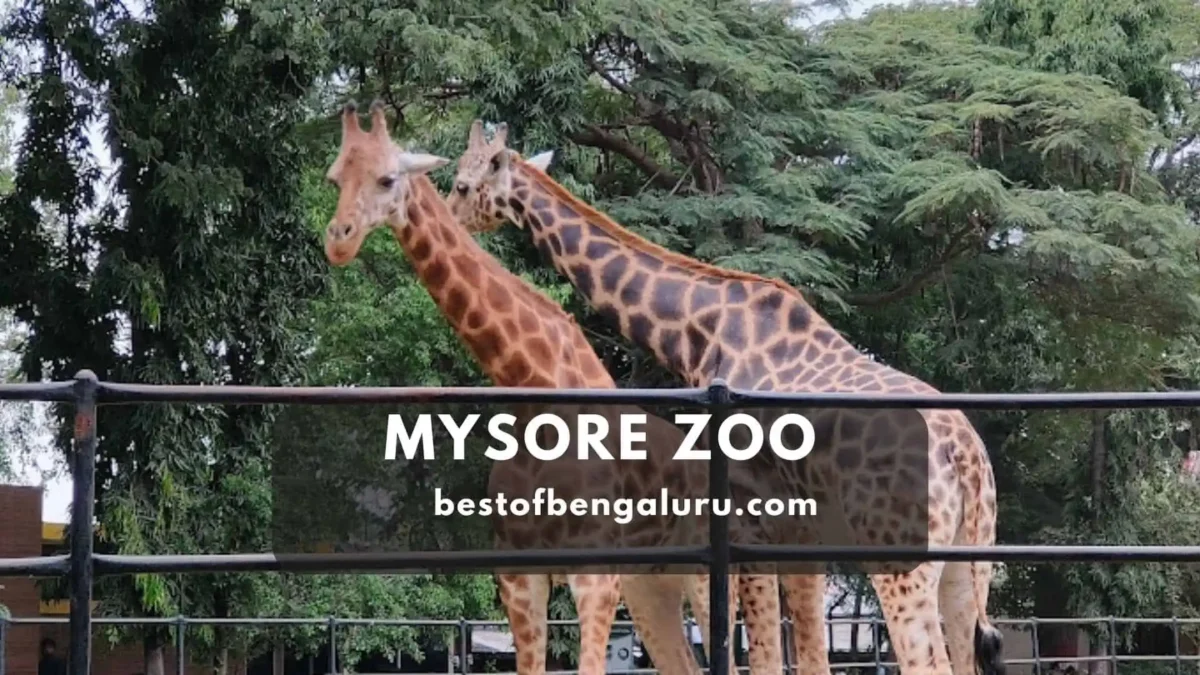Mysore Zoo Timings, Entry Fee, Ticket Price, Photos, Animal Details
Mysore Zoo, also known as Sri Chamarajendra Zoological Gardens, is one of the oldest and most popular zoos in India. It is located in the city of Mysore, Karnataka, which is famous for its rich cultural heritage and scenic beauty. The Zoo is home to a wide variety of animals and birds from different countries and continents. It is also a center for conservation, education, research, and recreation.

In this blog post, we will look at Mysore Zoo Timings, Entry Free, Ticket Prices, Photos, and Animal Details. We will also give you some tips on how to make the most of your visit to this amazing place.
Consider reading: Mysore Palace Timings, Ticket Price and Details
Mysore Zoo Timings
| Mysore Zoo Opening Days | Open all week except Tuesdays |
| Mysore Zoo Closed on Holidays | Republic Day, Independence Day, Gandhi Jayanti, Karnataka Rajyotsava |
| March to October Hours | 8:30 AM to 5:30 PM |
| November to February Hours | 8:30 AM to 5:00 PM |
| Entry Cutoff Time | Entry allowed till 4:30 PM |
| Special Attraction Timings | 10:00 AM to 4:30 PM (Aquarium, Reptile House, Walk-through Aviary, Butterfly Park), Closed on Tuesdays |
Mysore Zoo Entry Fee and Ticket Prices
Mysore Zoo Entry Fee
| Description | Rate (₹) |
|---|---|
| Adults | 100 |
| Children (5-12 Years) | 50 |
| Children (below 5 yrs) | Free |
Mysore Zoo Vehicle Parking
| Vehicle Type | Rate (₹) |
|---|---|
| Cycle | 15 |
| Two Wheeler | 40 |
| Car/Jeep/Auto | 70 |
| Mini Bus/Tempo | 125 |
| Bus | 175 |
Mysuru Zoo & Karanji Lake Combo Tickets
| Description | Rate (₹) |
|---|---|
| Adults | 130 |
| Children (5-12 Years) | 70 |
Mysore Zoo Camera & Luggage Charge
| Item | Rate (₹) |
|---|---|
| Video Camera | 200 |
| Still Camera | 100 |
| Luggage | 15 |
Mysuru Zoo Battery Operated Vehicles Ticket Prices
| Description | Rate (₹) |
|---|---|
| Adults | 200 |
| Children (5-12 Years) | 150 |
| Senior Citizen | 150 |
| Online 7 seater | 2400 |
Mysuru Zoo Student Concessions (In groups)
| Description | Rate (₹) |
|---|---|
| L.K.G/U.K.G | Free |
| 1st – 7th Std | 30 |
| 8th – 10th Std | 40 |
| Teacher (Accompanying 50 students) | 40 |
Note: For student concessions, it’s required to bring a student list on the school letterhead, signed by the head of the institution, along with individual ID cards issued by the institution. Student Concession will be stopped every year during the Dasara period.
You can buy Mysore Zoo Tickets online on the official website.
How to Reach Mysore Zoo
Reaching Mysore Zoo is a hassle-free experience, thanks to the well-connected transportation network in the region. The zoo is situated within easy reach of various transportation hubs:
- Air Travel: The closest airport to Mysore Zoo is Bangalore’s Kempegowda International Airport, approximately 170 km away. From Bangalore, visitors have the convenience of hiring a taxi, boarding a bus, or catching a train to Mysore, making the journey comfortable and straightforward.
- Rail Connectivity: For those preferring train travel, Mysore Junction is the nearest railway station, just 3 km from the zoo. Options for the short journey from the station to the zoo include auto-rickshaws, taxis, and city buses, offering flexibility and ease.
- Bus Access: The Mysore City Bus Stand, around 2 km from the zoo, serves as a convenient point for those arriving by bus. Similar to the railway station, the zoo is accessible from the bus stand via auto-rickshaws, taxis, or city buses.
- Road Trip: Driving enthusiasts can embark on a scenic drive from Bangalore to Mysore Zoo, covering a distance of about 155 km. The routes, SH 17 and NH 275, are known for their good maintenance and picturesque landscapes. The journey typically takes around 3 hours. Car rental and self-drive services are readily available in Bangalore for this purpose.
In summary, Mysore Zoo’s strategic location in Mysore city ensures smooth connectivity through air, rail, and road, offering multiple convenient options to reach this renowned wildlife sanctuary.
Consider reading: Places to Visit Near Bangalore
History of Mysore Zoo
The Mysore Zoo, officially known as the Chamarajendra Zoological Gardens, boasts a rich history dating back to 1892. Mysore Zoo was founded by Chamaraja Wodeyar X, the 23rd Maharaja of Mysore and a passionate animal enthusiast. Initially, the zoo was a private collection for the Maharaja’s palace, occupying 10 acres adjacent to his summer residence.
The Maharaja’s vision was brought to life with the help of G.H. Krumbeigal, a skilled German landscaper and horticulturist, who meticulously designed both the zoo and its enchanting gardens.
Initially known as the Palace Zoo, Zoo was opened to the public in 1902. In 1909, in honor of its founder, the Zoo was renamed Chamarajendra Zoological Gardens. Over time, the zoo underwent significant expansions and enhancements, thanks to various donations, exchanges, and acquisitions.
These efforts were not just limited to increasing its expanse and animal collection but also focused on enhancing the facilities and infrastructure for optimal animal care and welfare.
The Zoo has been a pioneer in conservation and breeding programs, particularly for endangered species, reflecting a commitment to wildlife preservation. In a landmark move in 1979, the zoo’s management was transferred to the Zoo Authority of Karnataka, making it India’s first autonomously managed zoo.
The zoo celebrated its centennial in 1992 and continues to be a premier attraction in Mysore, drawing visitors for its historical significance, conservation efforts, and diverse wildlife collection.
Animals at Mysore Zoo
Mysore Zoo, a veritable wildlife sanctuary, is renowned for its extensive collection, housing over 1,450 animals and 168 bird species from more than 25 countries across various continents. The zoo’s inhabitants represent a diverse array of wildlife, including mammals, reptiles, amphibians, fish, and invertebrates, offering a comprehensive glimpse into the animal kingdom.
The zoo’s residents include:
- African and Asian Mammals: Majestic African and Asian elephants, giraffes, zebras, hippos, rhinos, and camels.
- Big Cats and Predators: A variety of big cats like lions, tigers, leopards, cheetahs, jaguars, and hyenas from Africa, Asia, and America.
- European, Asian, and American Fauna: Bears, wolves, foxes, deer, antelopes, and bison from various continents.
- Australian Wildlife: Unique species like kangaroos, wallabies, emus, and cassowaries from Australia and Oceania.
- Primates: Gorillas, chimpanzees, orangutans, and gibbons from Africa and Asia.
- Birds of Various Origins: Colorful macaws, toucans, hornbills, flamingos, and peacocks from South America, Africa, and Asia.
- Aquatic and Amphibian Species: Crocodiles, alligators, gharials, turtles, and tortoises from diverse regions.
- Reptiles and Amphibians: Snakes, lizards, frogs, and salamanders from different parts of the world.
- Polar and Aquatic Creatures: Penguins, seals, and otters from colder regions, along with sharks, rays, eels, and various fish.
Notably, Mysore Zoo is a sanctuary for rare and endangered species such as the white tiger, king cobra, green anaconda, Komodo dragon, Aldabra giant tortoise, black swan, red panda, golden lion tamarin, and Humboldt penguin.
The zoo actively participates in various conservation and breeding programs, contributing to the preservation of these species, and has achieved notable success in breeding and raising many of them.
Consider reading: Bannerghatta National Park Animal Details
Tips for Visiting Mysore Zoo
Visiting Mysore Zoo can be a delightful experience for wildlife enthusiasts and families alike. To enhance your visit, consider these practical tips:
- Advance Planning: Before your visit, acquaint yourself with the zoo’s operating hours, holiday closures, and ticket pricing. The zoo is open daily except Tuesdays, with varying seasonal hours. Ticket prices differ for adults, children, senior citizens, and foreign nationals. Consider purchasing a combo ticket that includes Zoo and the adjacent Karanji Lake Park.
- Early Arrival for Optimal Experience: To fully appreciate the zoo, which spans 157 acres and houses 149 species, plan to spend 3 to 4 hours. The ideal times to visit are before 11:00 AM or after 3:00 PM, when animals are most active and crowds thinner.
- Respectful Conduct: Abide by the zoo’s regulations, such as the prohibition of plastics and disturbance to animals. Maintain silence, avoid flash photography and loud music, and dispose of waste responsibly to keep the zoo pristine.
- Utilizing Zoo Amenities: Enhance your comfort with the zoo’s amenities, including parking, a cafeteria, first-aid center, library, museum, electric vehicle service, children’s park, bandstand, boating, aviary, butterfly park, reptile house, and aquarium. Use the zoo map and staff assistance for easy navigation. Engage in events like photography competitions, summer camps, and conservation talks.
- Educational Aspect: The Zoo offers more than animal sightings; it’s an educational journey into wildlife conservation. Engage with informative displays and interact with knowledgeable staff to deepen your understanding of wildlife and conservation efforts.
In summary, maximize your Mysore Zoo visit by planning ahead, arriving early, respecting zoo rules and animals, utilizing available facilities, and embracing the educational opportunities the zoo offers.
Final Thoughts on Mysore Zoo
Mysore Zoo is a must-visit for wildlife enthusiasts and families alike. It’s conveniently accessible and operates every day except Tuesdays, with varying seasonal hours and ticket prices tailored for different visitor categories. The option of a combo ticket including Mysore Zoo and Karanji Lake Park further enhances its appeal.
To fully enjoy the zoo, visitors are advised to plan ahead, arrive early, respect the zoo’s regulations, make use of its facilities, and immerse themselves in the educational aspects of wildlife and conservation. The Zoo is more than just an animal sanctuary; it’s a place for fun, adventure, education, and creating lasting memories.
It offers an opportunity to connect with nature, appreciate the beauty of wildlife, and contribute to the vital cause of conservation and animal welfare. In essence, Mysore Zoo promises a wonderful and unforgettable experience for all its visitors.
FAQs on Mysore Zoo
What is the price of the Mysore Zoo ticket?
The ticket price for Mysore Zoo is ₹100 for adults, ₹50 for children aged 5-12 years, and free for children below 5 years.
Which animal is famous in Mysore Zoo?
Tigers, Giraffes, Elephants, and Zebras are famous in Mysore Zoo.
What is not allowed in Mysore Zoo?
Outside food is not allowed inside Mysore Zoo.
Which is better Bannerghatta or Mysore Zoo?
The Mysore Zoo ranks higher than Bannerghatta National Park for best Zoo in the country.





